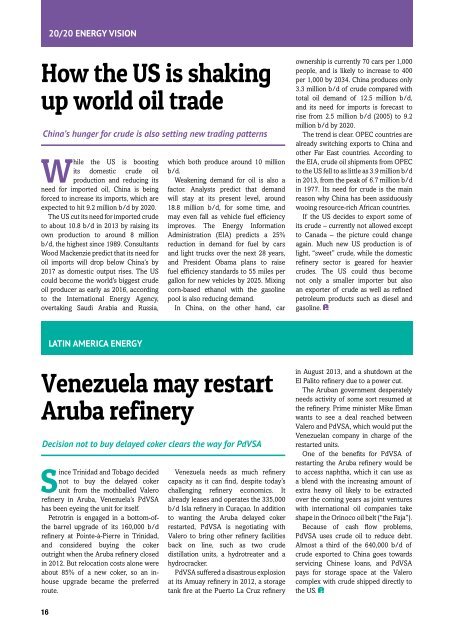ENERGY Caribbean newsletter (April 2014 • Issue no. 72)
The final edition of the ENERGY Caribbean newsletter
The final edition of the ENERGY Caribbean newsletter
- No tags were found...
You also want an ePaper? Increase the reach of your titles
YUMPU automatically turns print PDFs into web optimized ePapers that Google loves.
20/20 <strong>ENERGY</strong> VISION<br />
How the US is shaking<br />
up world oil trade<br />
China’s hunger for crude is also setting new trading patterns<br />
While the US is boosting<br />
its domestic crude oil<br />
production and reducing its<br />
need for imported oil, China is being<br />
forced to increase its imports, which are<br />
expected to hit 9.2 million b/d by 2020.<br />
The US cut its need for imported crude<br />
to about 10.8 b/d in 2013 by raising its<br />
own production to around 8 million<br />
b/d, the highest since 1989. Consultants<br />
Wood Mackenzie predict that its need for<br />
oil imports will drop below China’s by<br />
2017 as domestic output rises. The US<br />
could become the world’s biggest crude<br />
oil producer as early as 2016, according<br />
to the International Energy Agency,<br />
overtaking Saudi Arabia and Russia,<br />
which both produce around 10 million<br />
b/d.<br />
Weakening demand for oil is also a<br />
factor. Analysts predict that demand<br />
will stay at its present level, around<br />
18.8 million b/d, for some time, and<br />
may even fall as vehicle fuel efficiency<br />
improves. The Energy Information<br />
Administration (EIA) predicts a 25%<br />
reduction in demand for fuel by cars<br />
and light trucks over the next 28 years,<br />
and President Obama plans to raise<br />
fuel efficiency standards to 55 miles per<br />
gallon for new vehicles by 2025. Mixing<br />
corn-based etha<strong>no</strong>l with the gasoline<br />
pool is also reducing demand.<br />
In China, on the other hand, car<br />
ownership is currently 70 cars per 1,000<br />
people, and is likely to increase to 400<br />
per 1,000 by 2034. China produces only<br />
3.3 million b/d of crude compared with<br />
total oil demand of 12.5 million b/d,<br />
and its need for imports is forecast to<br />
rise from 2.5 million b/d (2005) to 9.2<br />
million b/d by 2020.<br />
The trend is clear. OPEC countries are<br />
already switching exports to China and<br />
other Far East countries. According to<br />
the EIA, crude oil shipments from OPEC<br />
to the US fell to as little as 3.9 million b/d<br />
in 2013, from the peak of 6.7 million b/d<br />
in 1977. Its need for crude is the main<br />
reason why China has been assiduously<br />
wooing resource-rich African countries.<br />
If the US decides to export some of<br />
its crude – currently <strong>no</strong>t allowed except<br />
to Canada – the picture could change<br />
again. Much new US production is of<br />
light, “sweet” crude, while the domestic<br />
refinery sector is geared for heavier<br />
crudes. The US could thus become<br />
<strong>no</strong>t only a smaller importer but also<br />
an exporter of crude as well as refined<br />
petroleum products such as diesel and<br />
gasoline.<br />
LATIN AMERICA <strong>ENERGY</strong><br />
Venezuela may restart<br />
Aruba refinery<br />
Decision <strong>no</strong>t to buy delayed coker clears the way for PdVSA<br />
Since Trinidad and Tobago decided<br />
<strong>no</strong>t to buy the delayed coker<br />
unit from the mothballed Valero<br />
refinery in Aruba, Venezuela’s PdVSA<br />
has been eyeing the unit for itself.<br />
Petrotrin is engaged in a bottom-ofthe<br />
barrel upgrade of its 160,000 b/d<br />
refinery at Pointe-à-Pierre in Trinidad,<br />
and considered buying the coker<br />
outright when the Aruba refinery closed<br />
in 2012. But relocation costs alone were<br />
about 85% of a new coker, so an inhouse<br />
upgrade became the preferred<br />
route.<br />
Venezuela needs as much refinery<br />
capacity as it can find, despite today’s<br />
challenging refinery eco<strong>no</strong>mics. It<br />
already leases and operates the 335,000<br />
b/d Isla refinery in Curaçao. In addition<br />
to wanting the Aruba delayed coker<br />
restarted, PdVSA is negotiating with<br />
Valero to bring other refinery facilities<br />
back on line, such as two crude<br />
distillation units, a hydrotreater and a<br />
hydrocracker.<br />
PdVSA suffered a disastrous explosion<br />
at its Amuay refinery in 2012, a storage<br />
tank fire at the Puerto La Cruz refinery<br />
in August 2013, and a shutdown at the<br />
El Palito refinery due to a power cut.<br />
The Aruban government desperately<br />
needs activity of some sort resumed at<br />
the refinery. Prime minister Mike Eman<br />
wants to see a deal reached between<br />
Valero and PdVSA, which would put the<br />
Venezuelan company in charge of the<br />
restarted units.<br />
One of the benefits for PdVSA of<br />
restarting the Aruba refinery would be<br />
to access naphtha, which it can use as<br />
a blend with the increasing amount of<br />
extra heavy oil likely to be extracted<br />
over the coming years as joint ventures<br />
with international oil companies take<br />
shape in the Ori<strong>no</strong>co oil belt (“the Faja”).<br />
Because of cash flow problems,<br />
PdVSA uses crude oil to reduce debt.<br />
Almost a third of the 640,000 b/d of<br />
crude exported to China goes towards<br />
servicing Chinese loans, and PdVSA<br />
pays for storage space at the Valero<br />
complex with crude shipped directly to<br />
the US.<br />
16


















